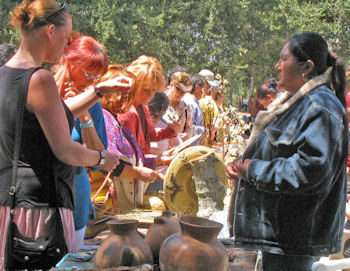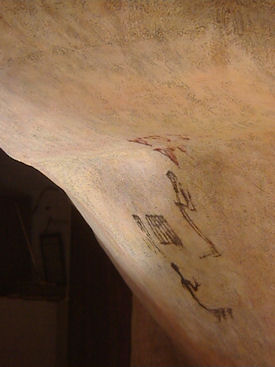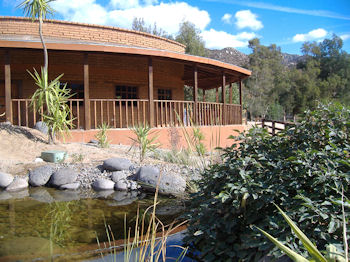 |  |
By Martina

Getting to the Kumiai village of San Antonio Necua is half the adventure. It is off the beaten path, and well worth the day trip to see into the early history of Baja California. Most Baja travelers will make it out to the Guadalupe Valley wine country. Who hasn't done wine tasting at LA Cetto? However, the true adventure begins as you pass Doña Lupe Winery and follow the first dirt road to the right. You know you are on the right track when you come to a dry arroyo (after rainfall expect to find the stream running). If your crossing is successful, you will enter the quiet Indigenous Community of the Kumiai.
History
The Kumiai have an oral tradition and no written history. Their song and stories were used to pass down their wisdom to each generation for thousands of years. One elder sings about storytelling, "Our stories were us, what we knew, where we came from, and where we were going. They reminded us of our responsibility to instruct, and to entertain...Stories were our life and they still are." One cannot help but be touched by the fact the Kumiai have lived in Baja successfully for 600 generations. Here in this village the ancient knowledge is still passed down. Now it is shared with outsiders who have lost the knowledge of how to live in right relationship with the earth. It is our great good fortune that this is so. There is no reason for their kindness considering their history with the United States. At one time the Kumiai were vastly populated, and found all the way into California Alta from the Salten Sea to Oceanside and south to Ensenada. The creation of the international border after the Mexican-American War ended in 1848 and the Treaty of Guadalupe Hidalgo "cut through the heart of the Kumeyaay ancestral homelands." It severed family groups who could no longer visit one another.

Today
The Kumeyaay, or commonly spelled Kumiai, community has a new look. Over the last ten years there has been an effort by the Mexican government and others to help the community to attract foreign visitors. Start with a beautiful tribute to the ancestors has been built in the midst of a once dusty village. Three main buildings constructed of natural adobe brick are reached by way of graceful pathways. There is a museum, gift shop and restaurant.
The spacious museum has an overpowering exhibit at the entrance. On a huge handmade rock there is a depiction of the first cave painting that was found in the mountains. Small black stick figures are etched on the rough surface as if charcoal from a long ago fire was used. At this time it is unknown what the meaning is of the geometric shapes below the figures, but a study is being done. This petroglyph is quite different than the larger and more colorful cave paintings of southern Baja. Venturing further, one finds a detailed display in delicate needle baskets of the region's endemic plants. Each display shows the uses that range from food source to medicinal; an example the Encino, Coast Live Oak. Its acorn is well known as a source of food after roasting, and surprisingly, also makes a savory cup of coffee. The beautiful woven reed and willow baskets have been utilitarian until modern time when collectors now pay thousands of dollars for just one. Gourds are grown, cleaned and create the ceremonial rattle that are used by the "singers" in the sacred ceremonies throughout the year.

Artisan booths are found inside the gift shop. Visitors can expect to find something that fits every budget from the delicate bird feather earrings and Indian dolls to museum quality coiled winnowing baskets and Pai Pai pottery. Opening in spring 2013 is the new restaurant, a rustic beauty with full industrial kitchen. Undoubtedly travelers will be able to sample authentic indigenous food having been served for generations. June 13, 2013 is the first Pow Wow open to travelers from around the world. This invitation is an important bridge between cultures. Put this adventure on your list of travel plans for 2013!
To visit the Kumiai village, its museum and shop - follow the "Ecoturismo Kumiai" signs past L.A.Cetto and Doña Lupe a couple of kilometers.
Martina's email: mteomaya(at)gmail.com

easy to buy On_Line website

Was so easy to purchase our insurance from Baja Bound, I am a senior and had no issues at all!

The level of service I have received from Baja Bound (Yara) has been nothing less than exceptional....